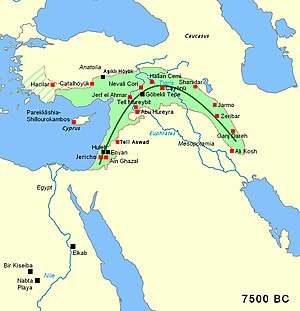8th millennium BC
The 8th millennium BC spanned the years 8000 BC to 7001 BC (c. 10 ka to c. 9 ka). It is impossible to precisely date events that happened around the time of this millennium and all dates mentioned here are estimates mostly based on geological and anthropological analysis.
| Millennia: | |
|---|---|
| Centuries: |
|

| Preceded by the Pleistocene |
| Holocene Epoch |
|---|
|
|
Blytt–Sernander stages/ages
*Relative to year 2000 (b2k). †Relative to year 1950 (BP/Before "Present"). |
| The Stone Age |
|---|
| ↑ before Homo (Pliocene) |
|
| ↓ Chalcolithic |
Communities
Neolithic culture and technology had become widespread in the Near East by 8000 BC. It was gradually spreading westward but is not believed to have reached Europe, still Palaeolithic, until about the end of this millennium. Planting and harvesting techniques were transferred through Asia Minor and across the Aegean Sea to Greece and the Balkans. The techniques were, in the main, cultivation of wheats and barleys; and domestication of sheep, goats and cattle.[1]
Though the Neolithic was now established throughout much of the Fertile Crescent, most people around the world still lived in scattered hunter-gatherer communities which remained firmly in the Palaeolithic. The world population was probably stable and slowly increasing. It has been estimated that there were some five million people c. 10,000 BC growing to forty million by 5000 BC and 100 million by 1600 BC. That is an average growth rate of 0.027% p.a. from the beginning of the Neolithic to the Middle Bronze Age.[2]
Fertile Crescent
By c. 7500 BC (see map above right), important sites in or near the Fertile Crescent included Jericho (Tell es-Sultan), 'Ain Ghazal, Huleh, Tell Aswad, Tell Abu Hureyra, Tell Qaramel, Tell Mureibit, Jerf el Ahmar, Göbekli Tepe, Nevalı Çori, Hacilar, Çatalhöyük, Hallan Çemi Tepesi, Çayönü Tepesi, Shanidar, Jarmo, Zrebar, Ganj Dareh and Ali Kosh. Jericho in the Jordan Valley continued to be the world's most significant site through this millennium.[3]
Çatalhöyük was a very large Neolithic and Chalcolithic proto-city settlement in southern Anatolia which flourished from c. 7500 BC until it was abandoned c. 5700 BC.[4] See image above right.
Pottery
Pottery found in the Near East at this time is classified as Pre-Pottery Neolithic B (PPNB) until c. 6500 BC. The Natufian culture co-existed with PPNB. The potter's wheel had not yet been invented and pottery was still hand-built, often by means of coiling, and pit fired.[5]
Agriculture in the Americas
It was from c. 8000 BC that agriculture developed throughout the Americas, especially in modern Mexico. There were numerous New World crops, as they are now termed, and domestication began with the potato and the cucurbita (squash) about this time. Other crops began to be harvested over the next 7,500 years including chili peppers, maize, peanut, avocado, beans, cotton, sunflower, cocoa and tomato.[6]
Environmental changes
The date of c. 7640 BC has been theorised for the impact of Tollmann's hypothetical bolide with Earth and the resultant global cataclysm.[7]
Other cultural developments
The date for construction of a round-house near Howick, Northumberland is calculated c. 7600 BC by radiocarbon dating. The site is believed to have been occupied for about 100 years.[8]
The homo sapiens fossil from Combe-Capelle in southern France, discovered in 1909, is estimated to be 9,500 years old (c. 7500 BC).[9]
The Mount Sandel Mesolithic site in Ireland is dated to c. 7900–7600 BC. This was long thought to be the earliest human activity on the island, until the discovery of the Alice and Gwendoline Cave pushed the date back to 10000 BC.[10]
References
- Roberts 1993, p. 37.
- Jean-Noël Biraben, "Essai sur l'évolution du nombre des hommes", Population 34-1 (1979), pp. 13-25.
- Bronowski 1973, pp. 64–69.
- Langer, William L., ed. (1972). An Encyclopedia of World History (5th ed.). Boston, MA: Houghton Mifflin Company. p. 9. ISBN 978-0-395-13592-1.
- Bellwood 2004, p. 384.
- For sources, see Timeline table in New World crops.
- Kristan-Tollmann, E.; Tollmann, A. (1994). "The youngest big impact on Earth deduced from geological and historical evidence". Terra Nova. 6 (2): 209–217. Bibcode:1994TeNov...6..209K. doi:10.1111/j.1365-3121.1994.tb00656.x.
- Richards, Julian (17 February 2011). "Britain's Oldest House?". bbc.co.uk. Retrieved 25 May 2019.
- "c. 7596–7577 cal BC (68.2% probability; 7601–7547 cal BC, 95.4% probability" Almut Hoffmann et al.: The Homo aurignaciensis hauseri from Combe-Capelle - A Mesolithic burial. Journal of Human Evolution 61(2), 2011, S. 211–214 doi:10.1016/j.jhevol.2011.03.001.
- "Another Life: The case of the kneecapped bear".
Bibliography
- Bellwood, Peter (November 30, 2004). First Farmers: The Origins of Agricultural Societies. Wiley-Blackwell. p. 384. ISBN 978-0-631-20566-1.
- Bronowski, Jacob (1973). The Ascent of Man. London: BBC. ISBN 978-1-849-90115-4.
- Roberts, J. M. (1993). Shorter Illustrated History of the World. Abingdon: Helicon Publishing Ltd. ISBN 0-1951-1504-X.